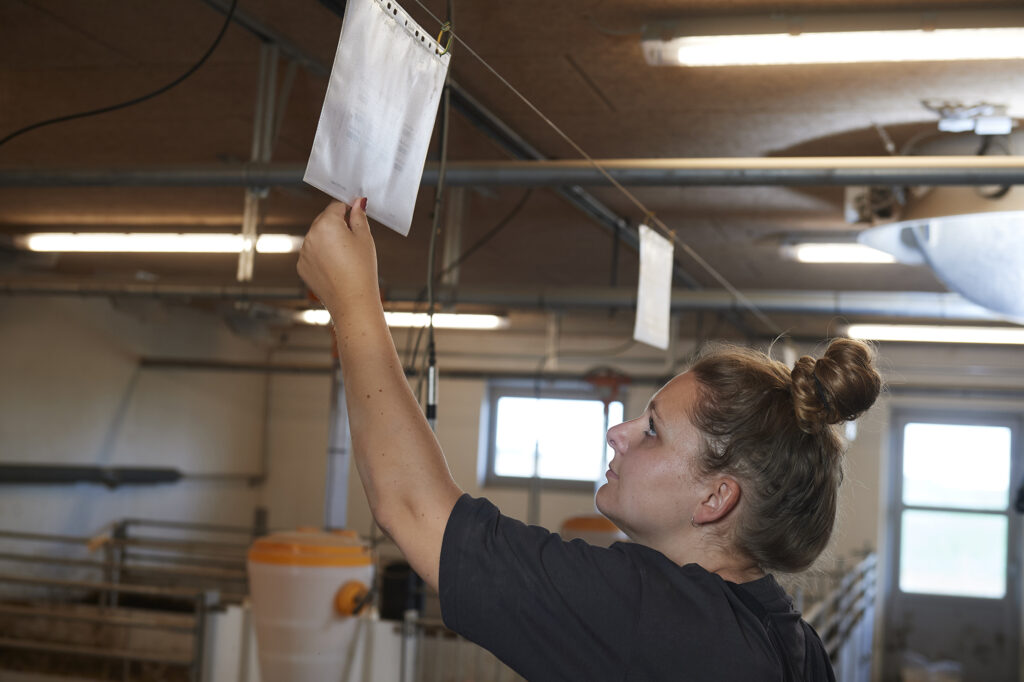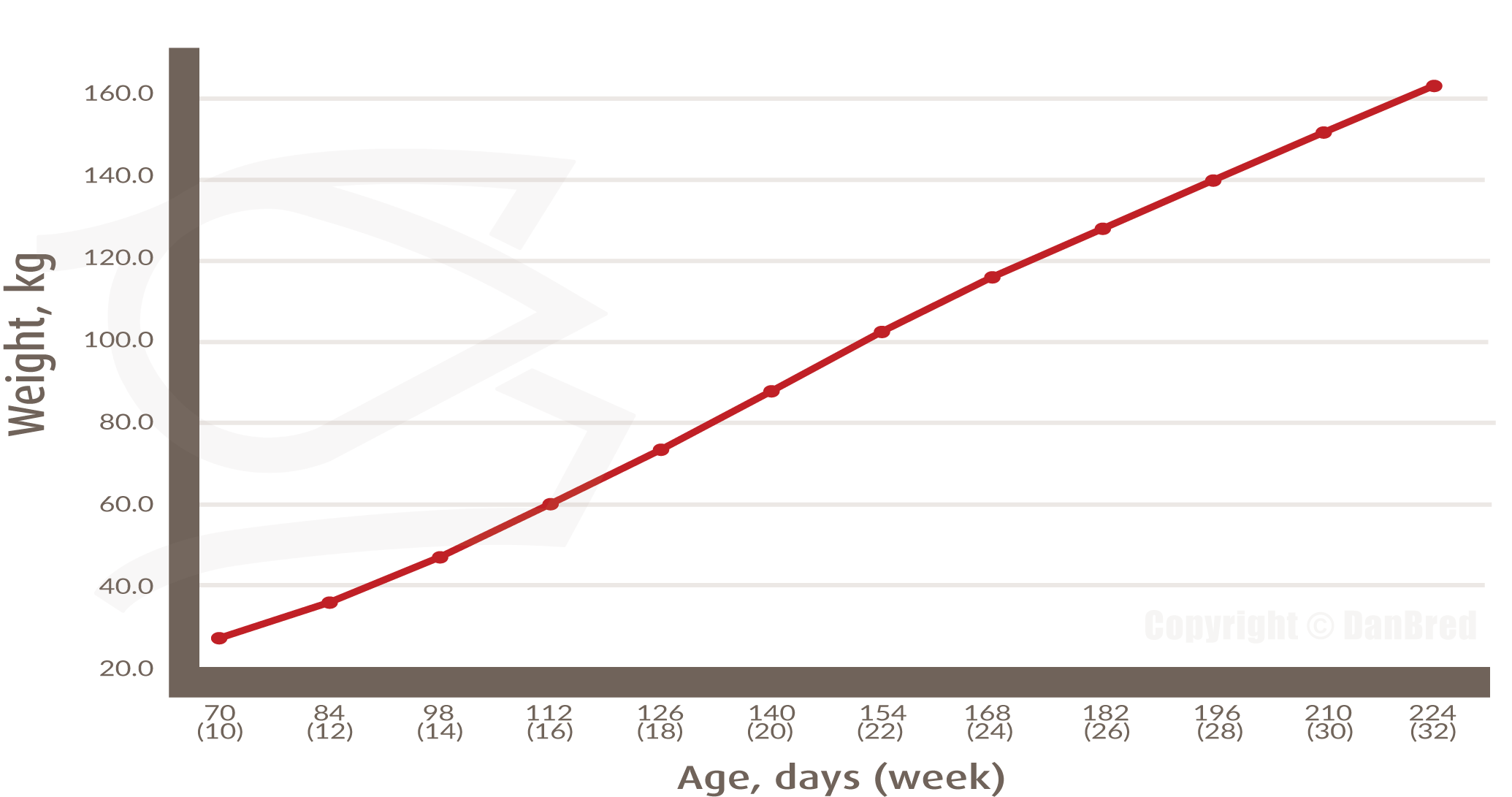Gilt Unit
At the end of the quarantine period, the gilts are ready to be transferred to the sow herd. We recommend using a closed filtered truck to transport the animals in order to maintain their health status during the move.

To help achieve a smooth transition for the new breeding animals, we recommend moving the gilts into the sow herd one pen at a time. Mixing the gilts will lead to fighting, so it is important to try to keep them in the same groups that they were in during the quarantine.

New gilts are usually of different ages when they are moved in with the sow herd. It is important that you adapt the feeding levels to the age of each gilt to ensure optimum growth before first mating.
Plan the transfer
All the gilts from the quarantine unit are moved to the sow herd. Depending on age, the gilts should be placed either in the gilt unit or directly into the mating unit:
- Plan the transport – remember to order transport if you use an external partner
- Prepare the pens in the sow herd
- If the gilts were not sorted when they went into quarantine, they should now be sorted by age and introduced to one of three units:
- Gilt unit
- Mating unit
- Electronic Sow Feeding (ESF) training pens, if you use ESF systems
If possible, keep the gilts in small groups of similar weight. Five to eight gilts to a pen, with a maximum weight difference of between 10 and 15kg.
Light
The recommended minimum light levels are 100 lux at gilt eye level 16 hours a day. Make sure all light sources are clean and produce the recommended amount of light. Be aware of any dark corners in the gilt unit. Natural light will produce a high amount of lux, but it is very sensitive to dirt on walls and windows, therefore it is a good idea to keep walls clean and paint them white.
|
|
|
Everyday tasks in the gilt unit
Focus on feeding and growth for each age group:
- Inspect all animals at least once a day – be aware of any signs of disease

- Check the growth in each age group once a week
 |
 |

Heat management and registering first heat
It is important to correctly detect when the gilts are in heat for the first time, as in order to set them up for a full lifetime of production, they need to be mated at the optimum age. Registering the first heat on a regular basis is a good tool for deciding which gilts to inseminate and when over the course of the next three weeks. It also gives you a good overview of the number of replacement gilts, helping you select among the older sows in the farrowing section. At this point, you can decide which sows to replace and which to return to the mating unit, which will help you keep the sizes of groups in the mating unit uniform.
- When the gilts are 28 weeks old, start introducing a teaser boar on a daily basis

- When first heat is detected, make sure you mark which gilts are in heat

- Note each gilt’s ID number and register the date or week number of the first heat

- Once the first heat is registered, you can track the gilt’s 21-day oestrous cycle
Heat registration
We recommend using a three-colour system for registering heat.
Assign one of the three colours to each week of the year, so that each colour appears in the same order every third week. For example, mark the back of gilts in heat:
Red in week one

Blue in week two

Green in week three

Red in week four
Blue in week five
Green in week six
Etc.
This gives you an overview of which, and how many gilts are in heat each week. Also, you will be able to see which gilts will be ready for insemination three weeks later.
You can group gilts with the same ‘heat colour’ into pens, or place them side by side in boxes 14 days before they come into heat again.
Colour scheme for heat registration
| Group number: | Date for first heat | |||
|---|---|---|---|---|
| Gilt ID number | Age | Red Group | Blue Group | Green Group |
Signs of gilts or sows in heat
- Swelling of the vulva
 |
 |
- Reduced appetite
- Increased activity in the pens
- Standing heat
|
|
|
Feeding
Phase feeding of DanBred gilts will secure good longevity and lifetime productivity. Feeding DanBred gilts according to one of the following feeding scenarios will assure optimised performance and fitness of the gilts.
| Scenario 1 | Gilts 30-60 kg | Gilts 60-110 kg | Gilts >110 kg |
|---|---|---|---|
| Scenario 2 | Gilts 30-85 kg | Gilts 85-110 kg | Gilts >110 kg |
Studies from SEGES Innovation, the Danish Pig Research Centre have shown that a daily gain of 900 g/day from 30 kg to 150 kg led to the best possible basis for long-term reproduction productivity. The table below shows recommended content of energy, Standardised Ileal Digestible (SID) content as well as content per kg feed for selected nutrients when using restricted feeding.
| Restricted feeding | Gilts 30-60(85) kg | Gilts 60-110 kg | Gilts 85-110 kg | Gilts >110 kg¹ |
|---|---|---|---|---|
| Energy density per kg feed | 13.0 MJ ME/ 9.8 MJ NE/ 1.07 EW |
12.8 MJ ME/ 9.7 MJ NE/ 1.05 EW |
12.7 MJ ME/ 9.6 MJ NE/ 1.04 EW |
12.5 MJ ME/ 9.4 MJ NE/ 1.02 EW |
| SID lysine per kg feed (g) | 8.2 | 6.3 | 5.2 | 4.1 |
| Total lysine per kg feed (g) | 9.4 | 7.2 | 6.0 | 4.7 |
| Min. SID crude protein per kg (g) | 126 | 105 | 94 | 82 |
| Phosphorous per kg (g)² | 5.6 | 4.4 | 4.4 | 3.9 |
| Digestible phosphorus per kg (g) | 3.2 | 2.4 | 2.4 | 2.0 |
| Calcium per kg (g) | 8.6 | 7.4 | 7.3 | 7.3 |
¹ This is also recommended for the mating unit.
² Based on the usage of 100% phytase
*NE = Net energy,; ME = Metabolic Energy; EW= Net Energy in Dutch evaluation system
Restricted feeding is recommended as it is the best way to control daily gain. Feeding gilts ad libitum increases the risk that daily weight gain will exceed recommendations.
Feeding
The feeding curve below shows phase feeding for gilts with three different diets.
To promote greater backfat deposit, we recommend changing the feed rations when the gilts weigh around 110 kg. Use a ration with 4.1 g SID lysine or less per kg and start feeding the gilts based on body condition.
Recommend feeding curve for gilts

If you are using an ESF system in the sow herd, it is important to train the gilts to use the feeders:
- Start training the gilts when they are around 22 weeks old – continue training for at least 2 weeks
- Proper ESF training requires calm animals, so we do not recommend you do ESF training if the gilts have just been regrouped/mixed or mating has started.




